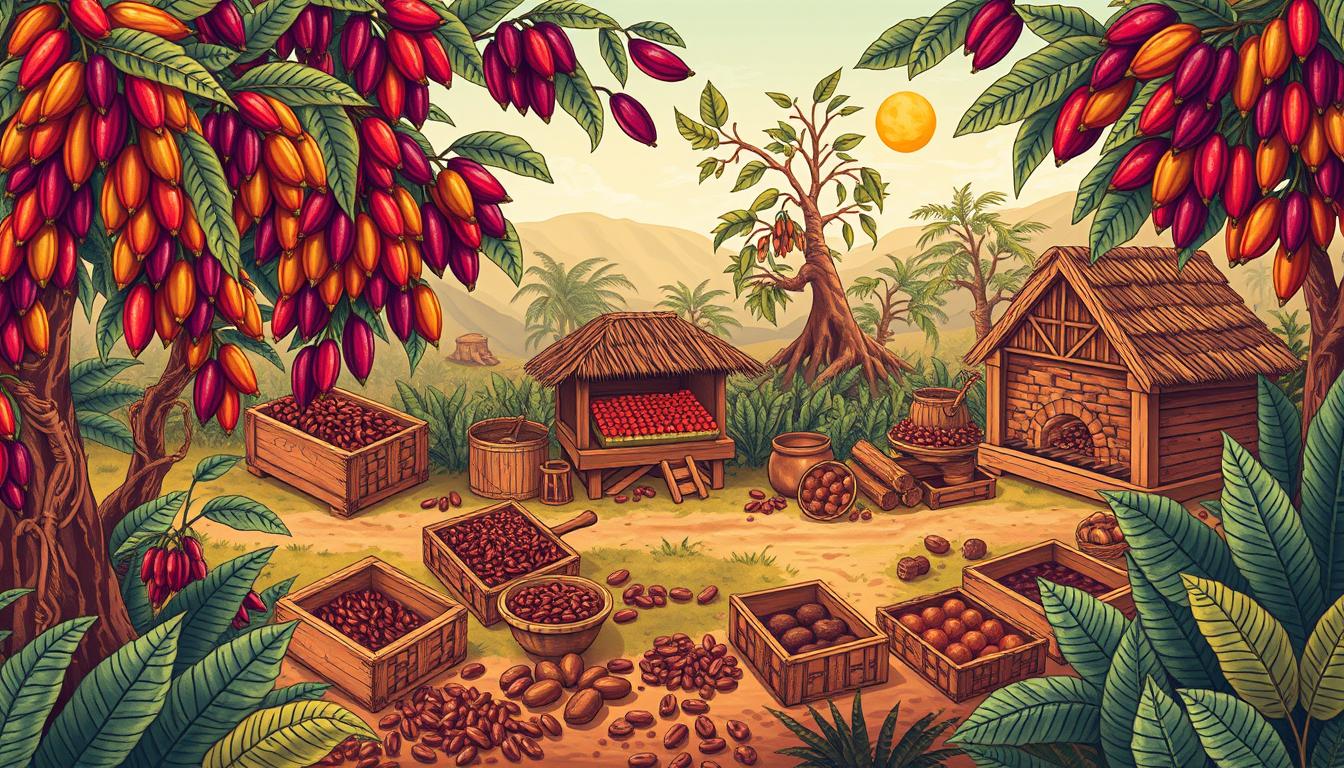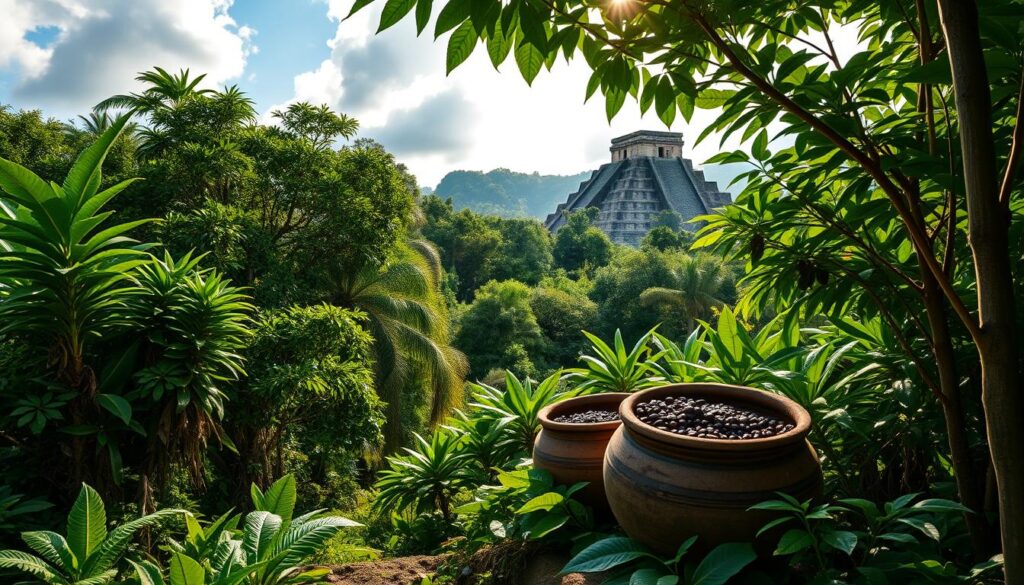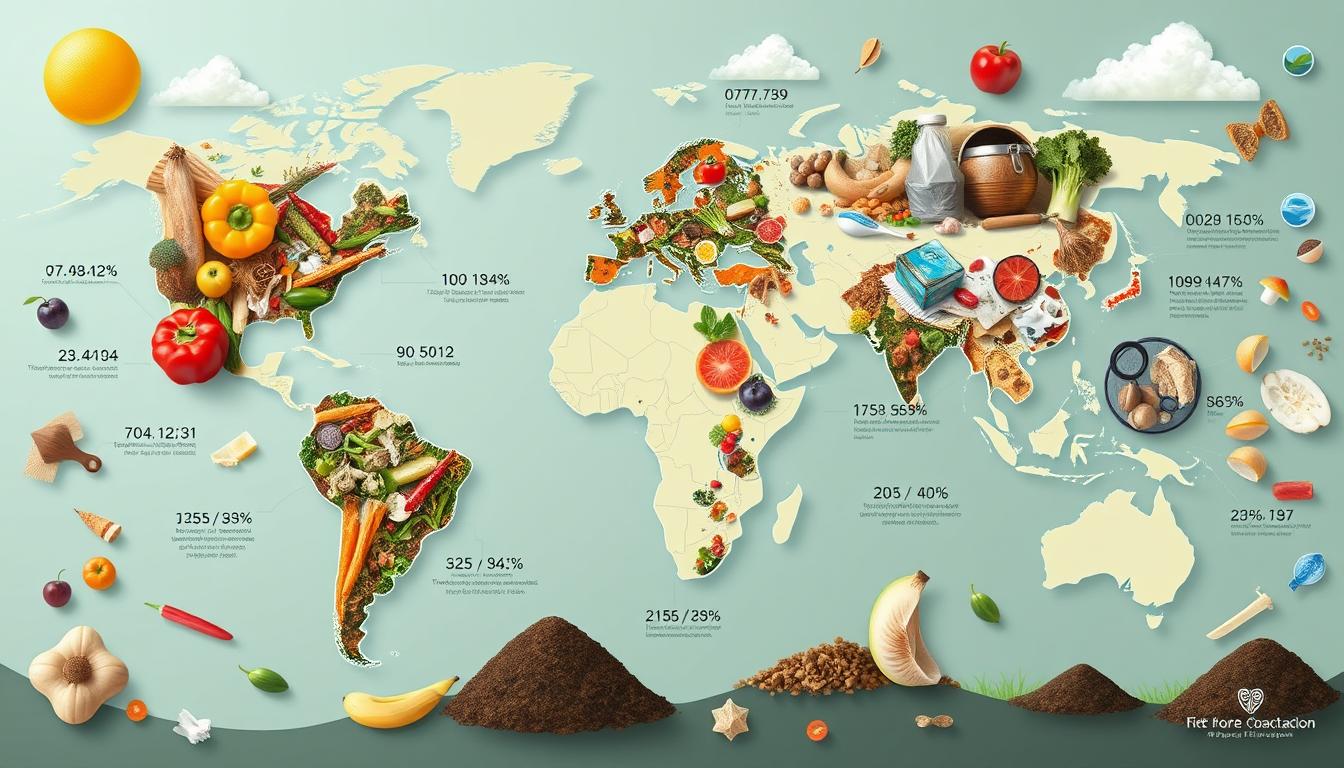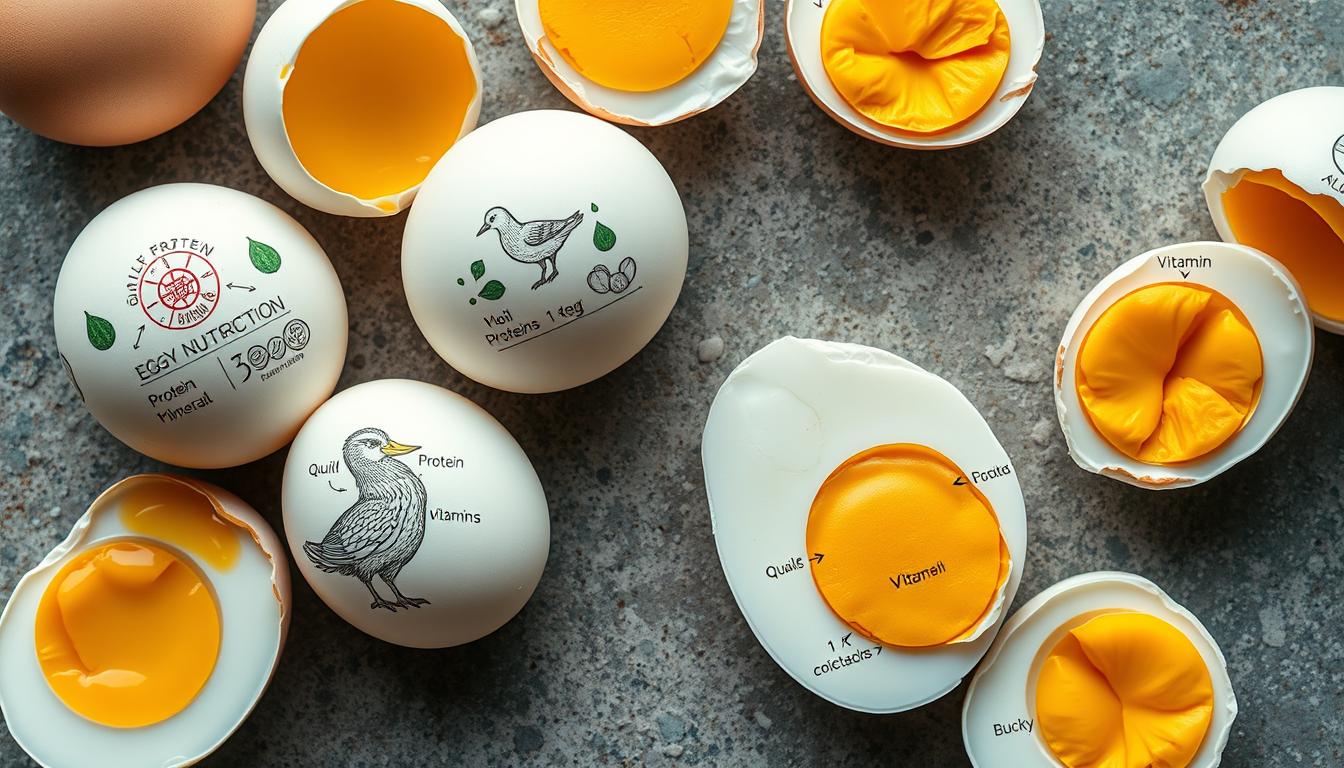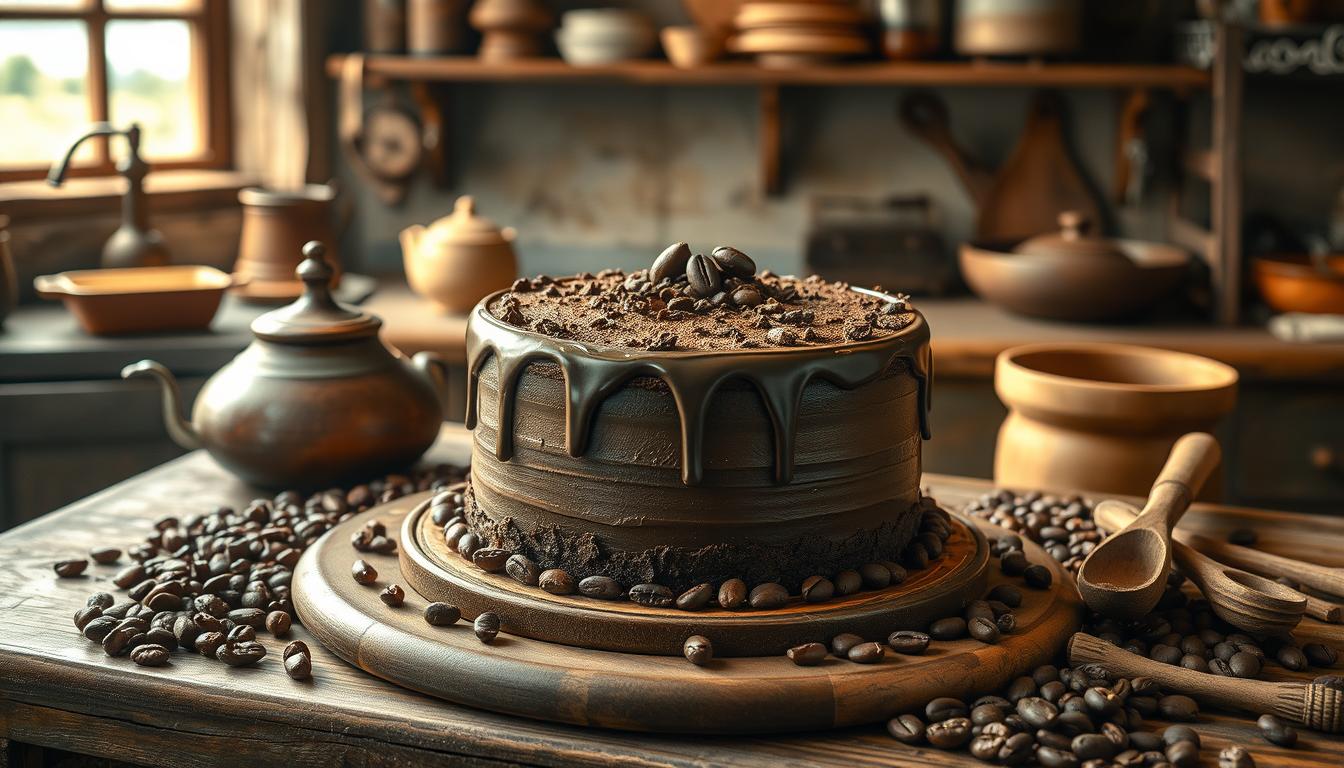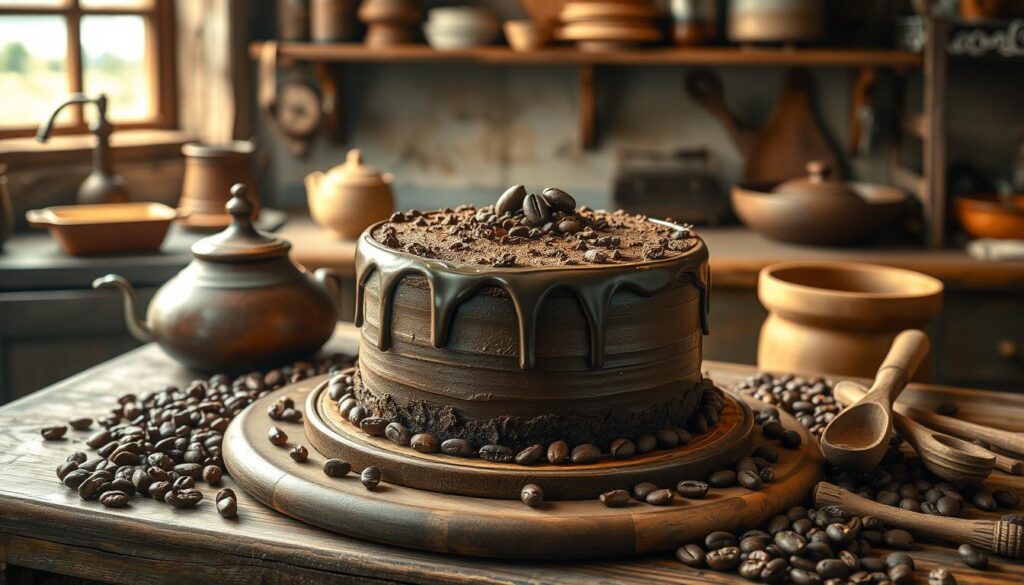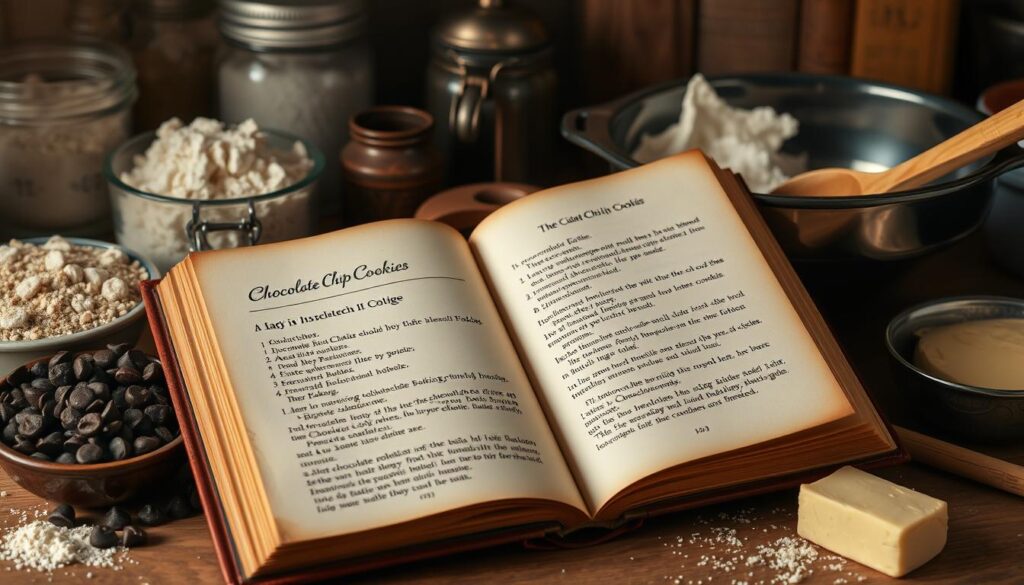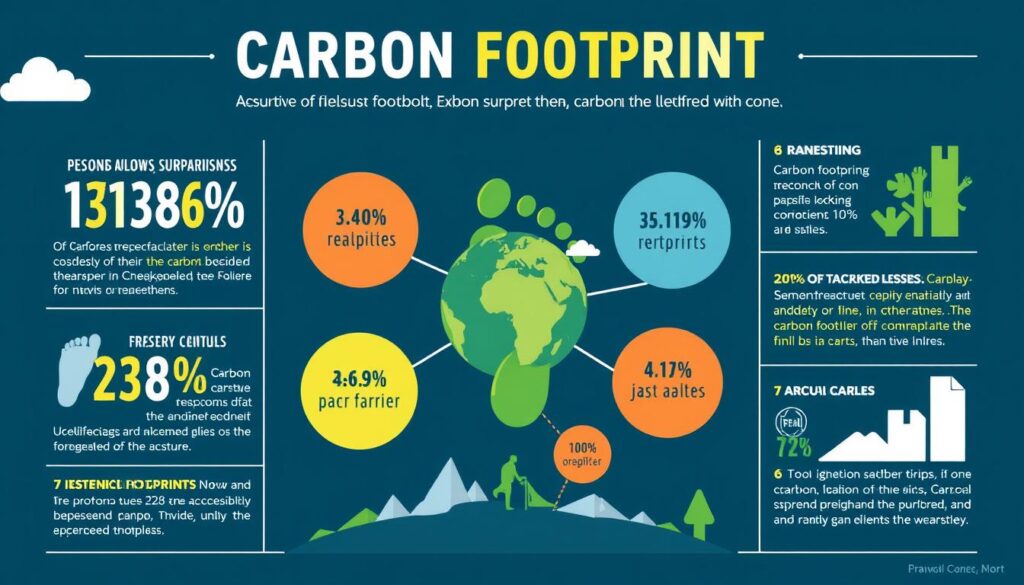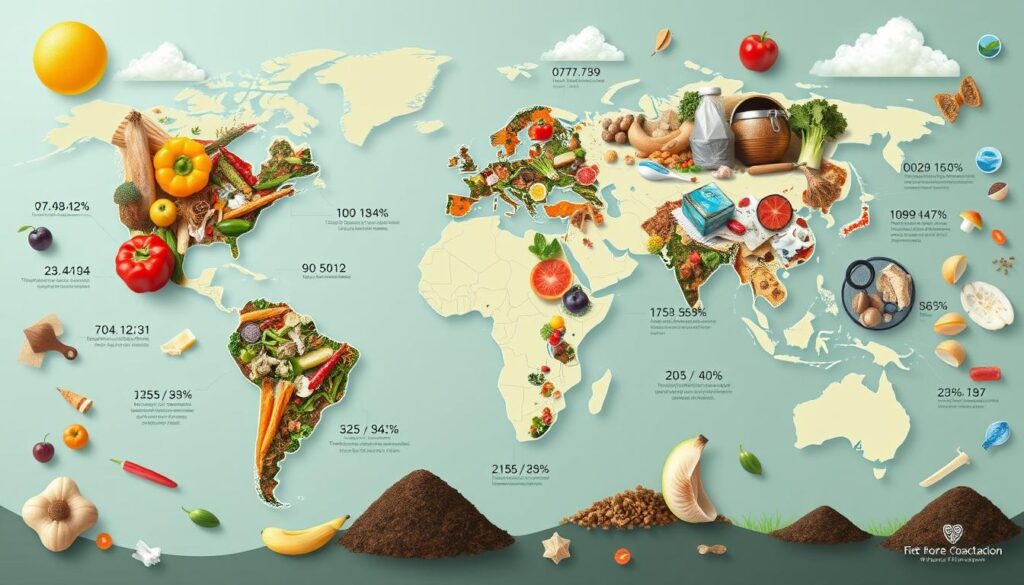Did you know the chocolate industry is worth over £100 billion? Chocolate has won hearts worldwide. Switzerland leads in chocolate consumption, with each person eating 11.8 kilograms in 2022. Its history and making process are both interesting and tempting.
The journey of chocolate starts with cacao beans. There are three main types: Criollo, Forastero, and Trinitario. The Ivory Coast is the biggest producer, making 2.15 million tons of cacao beans in 2020. Every year, five million tons of cocoa beans are made, and it takes 400 beans to make a pound of chocolate.
The making of chocolate is a detailed process. It includes steps like harvesting, drying, roasting, grinding, conching, and tempering. This careful work gives chocolate its smooth taste and rich flavor. The American Chemical Society says chocolate has over 600 aromatic compounds. This makes chocolate even more complex than wine.
Key Takeaways
- The chocolate industry is worth over £100 billion, with Switzerland being the top chocolate-consuming country.
- Chocolate has a rich history dating back to ancient Mesoamerican civilizations, where cacao beans were used as currency.
- Chocolate production involves several steps, from harvesting and drying cacao beans to roasting, grinding, conching, and tempering.
- Dark chocolate offers various health benefits, including antioxidants, possible heart benefits, and mood boosters.
- Chocolate has more than 600 aromatic compounds, making it more complex than wine in terms of flavor.
Table of Contents
- 1 Scientific Name for Chocolate is Theobroma Cacao
- 2 The Fascinating History of Chocolate
- 3 Chocolate has more flavor compounds than wine
- 4 Chocolate’s Production from Cocoa Beans
- 5 From Bean to Bar: The Chocolate Production Process
- 6 Chocolate’s History in the United States
- 7 Chocolate’s History in France
- 8 Chocolate’s History in England
- 9 Chocolate’s History in Switzerland
- 10 Chocolate’s History in China
- 11 Chocolate’s History in Mexico
- 12 The Health Benefits of Dark Chocolate
- 13 Chocolate in Popular Culture
- 14 The World’s Largest Chocolate Bar
- 15 Chocolate’s Unique Melting Point
- 16 The Complex Aroma of Chocolate
- 17 Chocolate and Love: A Sweet Connection
- 18 The Rise of Craft and Artisanal Chocolate
- 19 Source Links
Scientific Name for Chocolate is Theobroma Cacao
The cacao tree, which makes chocolate, is called Theobroma cacao. This name comes from Greek and means “food of the gods.” It shows how ancient people loved this plant. Small cacao trees can grow 40 pods a year. Most of these trees live near the equator.
Cacao and cocoa are often used to talk about the same plant. Ghana is known for making the best cocoa beans. Cocoa beans have over 300 flavors, making chocolate taste so good. In 2022, Ivory Coast made the most cocoa beans, followed by Ghana and Indonesia. That year, the world made about 5.9 million tonnes of cocoa beans.
Chocolate makers sort cacao beans into three groups: Forastero, Criollo, and Trinitario. Criollo beans are rare and special, making up 10% of chocolate. Forastero beans, like Amenolado and Arriba, are more common and make up 80%. Big companies like Hershey’s and Mars turn these beans into chocolate.
The use of cacao goes back a long time. The Mayo-Chinchipe people in Ecuador used it around 3300 B.C. The Olmec people in Mesoamerica started using cacao seeds around 1800 B.C. The Maya even used cocoa beans as money from the 8th century A.D. In the 1500s, Aztec ruler Moctezuma II drank 50 cups of cacao a day.
As chocolate became more popular, new ways to make it were found. In 1847, J.S. Fry and Sons made the first chocolate bars. In 1879, Rodolphe Lindt invented the conching process, making chocolate smooth. By the early 1900s, chocolate was more affordable for everyone.
Today, chocolate is loved by many. Events like the Salon du Chocolat in Paris show off chocolate’s many uses. When we eat chocolate, we think about its long history and journey from bean to treat.
The Fascinating History of Chocolate
Chocolate is loved by millions around the world. Its history is long and exciting, covering many centuries and places. From ancient Mesoamerica to Europe, chocolate’s story is as rich as the treat itself.
Ancient Mesoamerican Origins
The story of chocolate starts with the Aztecs and Mayans in Mesoamerica. They loved the cacao bean and made a drink called xocolatl. This drink was thought to be special and was even used as money by the Aztecs.
Chocolate as Currency
In Mesoamerica before Columbus, cacao beans were more than just food. They were used as money. The Aztecs paid taxes and gave gifts with these beans. Here’s how valuable they were:
| Item | Cacao Beans |
|---|---|
| 1 turkey hen | 100 beans |
| 1 hare or rabbit | 30 beans |
| 1 large tomato | 1 bean |
| 1 large avocado | 3 beans |
The Arrival of Chocolate in Europe
In the 16th century, Spanish explorers brought chocolate to Europe. They were amazed by the Aztecs’ xocolatl. Chocolate became a luxury for the rich and famous.
As more people wanted chocolate, cacao plantations were set up. These were mainly in West Africa. Sadly, this led to child labor and slavery in the chocolate industry.
Chocolate has more flavor compounds than wine
Chocolate is more than just a treat; it’s a complex food. The American Chemical Society found that chocolate has over 600 flavor compounds. This is three times more than red wine. This fact shows how rich and diverse chocolate’s taste is.
The aroma of chocolate comes from about 800 chemical compounds. These compounds are created during chocolate’s production. This includes harvesting cacao pods to tempering and molding the chocolate.
| Food | Number of Flavor Compounds |
|---|---|
| Chocolate | 600+ |
| Red Wine | 200 |
Chocolate’s many flavor compounds create a wide range of tastes. You can find fruity, floral, nutty, and earthy notes. This makes chocolate great for both sweet and savory dishes. It’s also a favorite with wines and other drinks.
Chocolate is not just tasty; it’s also good for you. It has antioxidants, polyphenols, and flavanols. These help with heart health, improve blood flow, and lower blood pressure. So, chocolate not only delights our taste buds but also has health benefits when enjoyed in moderation.
Chocolate’s Production from Cocoa Beans
The journey of chocolate starts with picking cacao beans from the Theobroma cacao tree, found in Central and South America. Each pod has about 40 cacao beans, which are carefully taken out and dried in the sun. Cacao trees can grow 20-30 pods a year, with each pod having 30-50 cocoa beans.
West Africa leads in cocoa production, with countries like Cote d’Ivoire and Ghana being top suppliers. About 70% of the world’s cocoa beans come from this area. Yet, African countries only eat about 3% of the world’s chocolate.
The United States is a big chocolate consumer, making up 20% of the global market, which is over 3 million tons a year. But, cocoa farmers in West Africa often struggle financially, with about 60% earning less than $1.90 a day because of market ups and downs.
| Region | Cocoa Production Share |
|---|---|
| West Africa | 70% |
| Rest of Africa | 30% |
After picking, the cocoa beans go through many steps to become the chocolate we love. They are roasted to remove moisture and bring out their aroma, a key step in creating the chocolate taste we enjoy.
Cocoa has been important in human history, from ancient Mesoamerican times to today. The Aztecs valued cacao beans more than gold, using them as money and seeing them as a gift from the gods. When chocolate came to Europe in the late 1500s, it was improved, like the creation of cocoa powder by Dutch chemist Coenraad van Houten in 1828 and the making of milk chocolate by Swiss chocolatier Daniel Peter in 1876.
Today, the cocoa industry has both challenges and chances. While mass production is common, there’s a growing interest in artisanal and bean-to-bar chocolate, focusing on the unique tastes and origins of the cacao beans. Also, there’s more focus on fair-trade chocolate production because of concerns about ethics and the environment.
From Bean to Bar: The Chocolate Production Process
The journey of chocolate making is fascinating. It starts with cacao beans and ends with the delicious treat we all love. Each step, from harvesting to tempering, is important for the taste, texture, and look of chocolate.
Harvesting and Drying Cacao Beans
Cacao pods are picked twice a year, from November to January and May to July. Each pod has 20–60 cocoa beans. It takes about 400 beans to make one pound of chocolate.
After picking, the beans are taken out of the pods. They go through fermentation and then sun-drying for up to 14 days.
Ecuador used to be a big cocoa producer. Now, most cocoa comes from West Africa, like Côte d’Ivoire and Ghana. Cacao trees only produce 50–60 pods a year, giving 15–20 pounds of beans.
Roasting and Grinding
The next step is roasting the dried cacao beans. Roasting is key for flavor. It’s done at 300-350°F for 30-60 minutes or more. Some makers use up to twelve types of cacao, roasting them for half an hour to two hours at 210-290F.
After roasting, the beans are cracked and winnowed. This removes the shells, which are almost 15% of the bean’s weight. The nibs are then ground into a thick paste called chocolate liquor. This step is important for flavor and texture.
Conching and Tempering
The chocolate liquor is refined to make it smooth. Cocoa butter is added to increase the fat content to 35-40%. Conching is then done to improve flavor and texture. This can take from a few hours to six days.
Tempering is the last step. It makes the chocolate glossy and perfect for melting. Before tempering, the chocolate is sifted to remove big particles. This makes the chocolate better.
From start to finish, making chocolate can take up to a week. The percentage on chocolate labels shows the cocoa solids by weight. Sugar is 100 minus the cocoa percentage.
Chocolate’s History in the United States
The story of chocolate in the United States is both rich and fascinating. It starts with the early American colonies. By the late 1770s, cacao beans were a big import, starting the country’s love for chocolate.
In 1765, chocolate making began in the American colonies at Dorchester, Massachusetts. The first American chocolate house opened in Boston in 1682. This marked the start of a thriving chocolate culture in the United States.
Milton Hershey is a key figure in American chocolate history. He started making chocolate bars in 1900. In 1907, he created Hershey’s Kisses, a beloved treat that shows American chocolate ingenuity.
The United States has seen many chocolate styles and innovations over the years. From the classic milk chocolate bar to the unique creations of bean-to-bar chocolate makers, the country’s chocolate scene is diverse and always changing.
Even with challenges like cocoa shortages and price changes, Americans’ love for chocolate never fades. Chocolate is a sweet treat, a gift, or a comfort. It holds a special place in the hearts and minds of Americans, tied to the nation’s rich culinary history.
Chocolate’s History in France
The history of French chocolate began in the 17th century. It was introduced by Queen Anne of Austria in 1615 as a gift to King Louis XIII. Back then, only the Kings of France enjoyed chocolate. The French monarchy even hired their own chocolate makers.
Queen Marie-Thérèse, Louis XIV’s wife, made chocolate popular among the aristocrats at Versailles. It became a symbol of status. King Louis XV also loved chocolate, making it even more popular in France. To make King Louis XV’s French hot chocolate, you need equal parts chocolate bars and water. Add an egg yolk for every four cups.
In 1659, David Chaillou opened France’s first chocolate factory. He had a monopoly for 29 years. By the 19th century, chocolate was mass-produced in France. In 1823, Debauve & Gallais introduced ‘dietary’ chocolates with orange blossom and vanilla. Menier, a pharmaceutical company, started selling chocolate as a recreational drug in 1814. By the end of the 19th century, Menier was the world’s largest chocolate factory.
French chocolate is known for less sugar and more cocoa than Belgian and Swiss chocolates. The Dufour family is credited with inventing the chocolate truffle in 1895. Today, brands like La Maison du Chocolat and Valrhona are famous worldwide for their quality chocolate. The pain au chocolat, a French morning pastry with chocolate, is a favorite among many.
| Year | Event |
|---|---|
| 1615 | Chocolate introduced to France by Anne of Austria |
| 1659 | First chocolate factory opened by David Chaillou |
| 1823 | Debauve & Gallais create ‘dietary’ chocolates |
| 1895 | Dufour family allegedly creates the chocolate truffle |
France now produces about 700,000 tonnes of chocolate every year. This shows France’s lasting love for chocolate.
Chocolate’s History in England
The story of chocolate in England is filled with luxury, innovation, and cultural importance. Initially, an English pirate thought chocolate was sheep droppings in 1579. But soon, it became a favorite among the English people. The first chocolate house in London opened in 1657, during Oliver Cromwell’s rule.
Chocolate was seen as a luxury, unlike coffee, which was more for the middle class. Samuel Pepys loved visiting chocolate houses in the 1660s for his morning drinks. Yet, there were rumors that Pope Clement XIV was poisoned with chocolate in the 17th century.
In the 19th century, the English chocolate industry boomed, employing over 1 million by 1810. Richard Cadbury, a Quaker, sold 16 drinking chocolate types by 1842. J.S. Fry & Sons created the first chocolate bar in 1847. They also made the first chocolate Easter egg in 1873.
Cadbury’s Dairy Milk in 1905 changed the chocolate scene in Britain. Today, 9 out of 10 people enjoy chocolate worldwide. The global chocolate market is worth $131.7 billion in 2019. Unique and artisanal chocolates are now in high demand.
| Chocolatier | Contribution | Year |
|---|---|---|
| Richard Cadbury | Sold 16 types of drinking chocolate | 1842 |
| J.S. Fry & Sons | Created the first chocolate bar | 1847 |
| J.S. Fry & Sons | Invented the chocolate Easter egg | 1873 |
| Cadbury’s | Introduced Dairy Milk | 1905 |
From being mistaken for sheep droppings to becoming a global favorite, chocolate’s journey in England shows the creativity and dedication of chocolatiers like Cadbury and J.S. Fry & Sons.
Chocolate’s History in Switzerland
Switzerland has been key in the chocolate world. Swiss chocolatiers introduced new ways to make chocolate. Figures like Daniel Peter and Rodolphe Lindt changed how we enjoy chocolate.
In 1875, Daniel Peter made the first solid milk chocolate. He used condensed milk for a smoother taste. This made Swiss chocolate very popular.
Rodolphe Lindt’s conching process in 1879 was a big step. It mixes chocolate for hours, making it velvety. Lindt’s work and Switzerland’s quality rules mean “Swiss Chocolate” is top-notch.
Swiss chocolate makers pick the best cocoa beans. They use 100% cocoa butter, no added oils. This focus on quality and new flavors keeps Switzerland leading in chocolate.
The chocolate industry is huge now, worth over £100 billion. Switzerland’s role is big, with lots of chocolate made and eaten. By 1905, Switzerland made 15,000 tonnes of chocolate, a lot of which was sold abroad. In 2022, each person ate 11.8 kilograms of chocolate.
| Year | Event |
|---|---|
| 1875 | Daniel Peter creates first milk chocolate |
| 1879 | Rodolphe Lindt invents conching process |
| 1901 | Union libre des fabricants suisses de chocolat founded |
| 1936 | Nestlé invents white chocolate |
| 2017 | Barry Callebaut invents ruby chocolate |
Swiss chocolatiers keep making new chocolate. Nestlé made white chocolate in 1936 and Barry Callebaut introduced ruby chocolate in 2017. Switzerland’s love for quality keeps it a leader in chocolate, making treats that everyone loves.
Chocolate’s History in China
Chocolate has a short history in China but is becoming more popular. This is because the country’s middle class is growing and Western tastes are spreading. Despite the global chocolate trade being worth over $100 billion in 2018, the Chinese eat much less chocolate than the British.
Chocolate production has skyrocketed, with most coming from Ghana and Cote d’Ivoire. Yet, Africans don’t eat much chocolate themselves.
The history of chocolate goes back over 2,000 years. It was first domesticated around 3300 BC in the Amazon. The Maya and Aztecs used it as a drink and even as money.
In the 19th century, chocolate reached Europe and the U.S. thanks to new production methods. Today, Americans eat about 12 pounds of chocolate each year, totaling 2.8 billion pounds in 2013.
Even though the Chinese don’t eat as much chocolate as Westerners, the demand is rising. As the Chinese middle class grows and adopts more Western tastes, chocolate will likely become more popular in China.
| Country | Chocolate Consumption (per capita) |
|---|---|
| Switzerland | 19.8 lbs |
| United States | 9.5 lbs |
| China | 0.1 lbs |
As the data shows, chocolate consumption in China is significantly lower than in Western countries like Switzerland and the United States. Yet, with a growing middle class and more Western influences, the Chinese chocolate market has a lot of room to grow.
Chocolate’s History in Mexico
Mexico is where chocolate first came to life, thanks to the Aztecs and Mayans. They loved chocolate so much, it’s been found in Mexico from as far back as 1750 B.C.
The Aztecs thought chocolate was a gift from their god, Quetzalcoatl. They even traded cacao beans for gold. Their emperor, Montezuma, drank up to 50 cups of chocolate daily.
There’s a debate on where the word “chocolate” comes from. Some say it’s from the Nahuatl or Yucatec Maya languages. When the Spanish brought chocolate to Europe, they added cinnamon, milk, and sugar.
European rule led to big cacao plantations in Mexico and the Americas. This hurt Indigenous workers and African slaves. Today, Mexicans love their chocolate as a frothy drink, often unsweetened. They also enjoy special drinks like pozol and champurrada, made with cocoa and spices.
Mexican chocolate is also used in cooking, adding a deep flavor to dishes like mole poblano sauce. A cacao tree can live over 200 years. But only 1 in 500 flowers will grow into a pod. It takes 400 beans to make a pound of chocolate, with fermentation and making a bar taking days.
| Civilization | Chocolate Use |
|---|---|
| Aztecs | Spiced beverage, currency |
| Mayans | Spiced beverage, ritual offerings |
From ancient times to today, chocolate is a big part of Mexico’s culture. The world loves chocolate, with Americans eating over 10 pounds a year. Mexico’s role in chocolate’s history is truly important.
The Health Benefits of Dark Chocolate
Dark chocolate, with its high cocoa content (70% or more), is packed with health perks. It’s full of antioxidants, which protect cells from damage. A 100-gram bar of dark chocolate with 70–85% cocoa has 11 grams of fiber and 66% of the DV for iron.
It also has 57% of the DV for magnesium, 196% for copper, and 85% for manganese. A 101-gram bar of dark chocolate with 70–85% cocoa solids has about 604 calories and 7.87 g of protein.
Rich in Antioxidants
Dark chocolate is loaded with antioxidants like flavanols and polyphenols. These compounds fight free radicals and reduce oxidative stress. But, some of these good stuff can be lost during processing.
Potential Cardiovascular Benefits
Dark chocolate may lower the risk of heart disease. Eating it three times a week can cut cardiovascular disease risk by 9%. Consuming 45 grams of chocolate weekly can lower the risk by 11%.
The flavanols in dark chocolate can also help lower blood pressure. They might also boost HDL cholesterol and reduce LDL cholesterol. Dark chocolate’s anti-inflammatory compounds can also reduce body inflammation.
Mood-Enhancing Properties
Dark chocolate may improve mood, but the exact reasons are not known. Flavanols in dark chocolate can enhance brain function and prevent neurodegenerative conditions. Research shows cocoa flavanoids may also help older adults with mild cognitive impairment.
To get the most health benefits, choose dark chocolate with 70% or higher cocoa content. Aim for 20-30g of dark chocolate daily, with at least 70% cacao solids. But, be aware of lead and cadmium in some dark chocolate, with Ghirardelli, Mast, Taza, and Valrhona being safer brands in 2022.
Chocolate in Popular Culture
Chocolate has been a favorite treat for centuries. It’s loved not just in kitchens but also in books, movies, theme parks, and museums. It’s a cultural phenomenon that fascinates people worldwide.
Chocolate in Literature and Film
Chocolate shines in books and movies. Films like Chocolat and Charlie and the Chocolate Factory celebrate its magic. In Chocolat, a woman’s chocolate shop changes a French village. Charlie and the Chocolate Factory follows a boy’s adventure in Willy Wonka’s factory.
Books like Like Water for Chocolate and The Chocolate Touch show chocolate’s power to move us. These stories, and many more, have made chocolate a staple in culture.
Chocolate-Themed Attractions and Events
Hersheypark in Pennsylvania, USA, is a chocolate lover’s dream. It offers rides, shows, and lots of chocolate. The park honors Milton Hershey, who started The Hershey Company at 30.
The Chocolate Museum in Cologne, Germany, is another must-visit. It explores chocolate’s history from ancient Mesoamerica to today. Visitors can see chocolatiers at work and taste their creations.
Chocolate festivals worldwide celebrate its appeal. The Salon du Chocolat in Paris is a highlight, with over 500 participants from 60 countries. Other notable festivals include the Ghirardelli Square Chocolate Festival in San Francisco and the Eurochocolate Festival in Perugia, Italy.
Chocolate has made a lasting impact on culture. From books to movies, and from parks to museums, it’s a beloved treat. World Chocolate Day on July 7 celebrates its introduction to Europe in the 16th century.
The World’s Largest Chocolate Bar
In the world of chocolate, records are made to be broken. On October 7, 2011, Thorntons plc, a renowned British chocolate company, created the world’s biggest chocolate bar by weight. It weighed an astonishing 12,770 lb 4.48 oz. This massive confection was made to celebrate the company’s 100th anniversary, showing their skill and love for chocolate.
The size of this chocolate bar is truly amazing. It’s heavier than a fully-grown African elephant. It’s even bigger than the largest chocolate sculptures, which can weigh up to 22,000 pounds. Making such a huge chocolate bar is a big challenge. It needs special tools, careful temperature control, and a team of expert chocolatiers.
While Thorntons plc holds the record for the heaviest chocolate bar, others have also made big achievements. In February 2020, Frits van Noppen in Rotterdam, Netherlands, made the largest chocolate bar by area. It was 383.24 square meters big. Russell Stover Candies in the United States also made a huge box of chocolates. It weighed over 5,000 pounds and was 30 feet 4.5 inches wide by 15 feet 5 inches tall.
The chocolate industry is worth over £100 billion globally. It keeps getting bigger and making chocolate lovers happy all over the world. From the first chocolate factory in 1728 by Joseph Fry in the United Kingdom to the longest line of chocolate bars in Mumbai, India, with 5,130 bars, chocolate has many amazing stories and surprises.
Chocolate’s Unique Melting Point
Chocolate melts just below our body temperature, around 93°F (34°C). This makes it melt smoothly and quickly in our mouths. It’s a big reason why chocolate feels so good to eat.
Different types of chocolate melt at different temperatures. Dark chocolate, with 86% cacao solids or more, starts to melt at 46°C. White chocolate, with about 20% cocoa butter, melts between 37-43°C because of its powdered milk and milk fats.
Milk chocolate, with 20% to 50% cacao solids, melts between 40-45°C. Some chocolatiers use milk chocolate with more cacao for a smoother texture and richer flavors.
The way cocoa butter crystallizes affects how chocolate melts. Type 1 crystals melt at 17.3°C, making chocolate soft and crumbly. But Type 5 crystals, melting at 33.8°C, are best for chocolate because they melt near body temperature. They give chocolate a crisp snap and a great mouthfeel.
To keep melted chocolate runny, add vegetable oil or coconut oil and stir well. This trick is handy for dipping, coating, or making decorations.
| Chocolate Type | Cacao Solids | Melting Point |
|---|---|---|
| Dark Chocolate | 86% or more | 46°C |
| Milk Chocolate | 20% to 50% | 40-45°C |
| White Chocolate | Around 20% cocoa butter | 37-43°C |
Knowing chocolate’s melting point is key for chocolate lovers and professionals. It helps make chocolate products with the best texture and mouthfeel. This makes the chocolate experience even better.
The Complex Aroma of Chocolate
The smell of chocolate is complex, with over 600 volatile components. These can be earthy, fruity, or floral, adding depth to the experience.
The smell of chocolate changes based on where the beans come from, how they’re fermented, and how they’re roasted. Roasting creates new flavors through Maillard reactions.
Different chocolates smell different. Dark chocolate has rich cocoa and coffee notes. Milk chocolate smells like caramel and vanilla, bringing comfort. White chocolate is sweet, with hints of vanilla and caramel.
Adding ingredients like orange or cinnamon can change the smell of chocolate. Mint or raspberry can also add to its aroma.
Sweeteners like sugar and honey affect the smell of chocolate. Roasting sugar adds a caramel aroma. Stevia or erythritol can also change the smell.
The smell of chocolate affects how we taste it and how we feel. Phenylethylamine in chocolate makes us happy. It can also reduce stress and improve mood.
Good chocolate smells right, with a mix of aromas. Bad smells can come from low-quality beans or poor processing.
In summary, chocolate’s smell is key to its enjoyment. The mix of smells and tastes makes chocolate special.
Chocolate and Love: A Sweet Connection
Chocolate and love have been linked for centuries. It’s often given as a gift on Valentine’s Day or other special days. In 2022, Valentine’s Day sales hit a record $4.1 billion.
This year, 92% of Americans plan to celebrate with chocolate and candy. And 93% want chocolate or candy as a gift.
Some think chocolate is an aphrodisiac, but science isn’t sure. Yet, a 2007 study showed chocolate can make your heart beat faster than kissing. It also caused more brain activity.
Giacomo Casanova, known for his charm, preferred hot chocolate over champagne. He called it ‘The Elixir of Love’.
The heart-shaped chocolate box was invented in 1868 by Richard Cadbury. It’s celebrating its 155th anniversary in 2023. Every year, 40 million heart-shaped boxes are sold in the U.S. for Valentine’s Day.
The chocolate industry is worth over £100 billion globally. Switzerland leads in chocolate consumption, with 11.8 kilograms per person in 2022.
Belgian researchers found that chocolate can boost romance novel and cookbook sales by 40%. Belgium is famous for its top-notch chocolate pralines. Dark chocolate is also good for your health.
Eating 25 pounds of chocolate might be needed to feel its aphrodisiac effects. But a 2014 study showed chocolate can make single people dream of love more than salty snacks. So, enjoying chocolate or making vegan sweet potato waffles, the bond between chocolate and love is as delightful as ever.
| Chocolate Fun Facts | Details |
|---|---|
| World’s Largest Chocolate Bar | 12,000 pounds, created in the UK by Thorntons plc |
| First Chocolate Bar | Made in 1847 by Joseph Fry, a British confectioner |
| Cocoa Beans per Pound of Chocolate | Approximately 400 cocoa beans |
| World’s Largest Chocolate Sculpture | 22,000 pounds |
The Rise of Craft and Artisanal Chocolate
Chocolate has changed a lot in recent years. Now, we see more craft and artisanal chocolate makers. They focus on quality, sustainability, and unique tastes. This movement goes back to ancient Mesoamerican civilizations, where chocolate first appeared over 5,000 years ago in Ecuador.
This craft chocolate movement is all about going back to the old ways. It’s about taste, care, and fair sources, unlike the big industrial chocolate of the past.
Craft chocolate is made in small batches by skilled artisans. This makes it more expensive than mass-produced chocolate. It’s because they use top-quality ingredients, like single-origin cacao beans, and focus on fair and sustainable sources.
In the last 20 years, a group of chocolatiers has been working hard. They aim to give Americans better chocolate than what’s found in supermarkets. They focus on quality over quantity.
These makers often work directly with cacao farmers. This helps ensure fair trade and supports local communities.
Bean-to-Bar Chocolate Makers
Bean-to-bar chocolate makers are at the core of this movement. They handle every step, from getting the cacao beans to making the chocolate. This hands-on approach lets them focus on the details and appreciate each cacao variety’s unique qualities.
Companies like The Chocolate Fetish work with a network of chocolate makers. They pick the best chocolates for their products, ensuring top quality.
Unique Flavor Combinations and Inclusions
Craft chocolate makers are always trying new things. They mix unique flavors and add special inclusions. This can include exotic fruits, spices, bacon, or olive oil. They’re always looking to surprise and delight our taste buds.
While dark chocolate is often seen as high-quality, there’s also amazing milk chocolate out there. People should try different chocolates to find what they like, no matter the type.
Source Links
- 50 Fun Facts About Chocolate You Never Knew – https://www.kronchocolatier.com/blogs/news/50-fun-facts-about-chocolate-you-never-knew?srsltid=AfmBOorz5hjsoBLozGtazRDFu-m4XJOkd7DyRtydPQZCGLuXDx1N_8G0
- Chocolate for the Heart: A Brief History in 40 Fun Facts – https://simplylocalbillings.com/chocolate-for-the-heart-a-brief-history-in-40-fun-facts
- Chocolate science, history and fun facts – Part 1 – https://www.canr.msu.edu/news/chocolate_science_history_and_fun_facts_part_1
- Theobroma cacao – https://en.wikipedia.org/wiki/Theobroma_cacao
- The secret history of chocolate – https://kids.nationalgeographic.com/history/article/the-secret-history-of-chocolate
- Fun Facts About Chocolate – https://www.whitakerschocolates.com/blogs/blog/fun-facts-about-chocolate?srsltid=AfmBOoqygISRXa-wUmyYoXouRdXj5rzQEzowvvirAK5Lp1rCkW3T2OxU
- 17 Crazy Facts about the History of Chocolate – https://www.thecollector.com/history-of-chocolate-facts/
- 5 Fun Facts About Chocolate — Zazubean Organic Chocolate – https://www.zazubean.com/blog/chocolate-fun-facts
- History of Chocolate: Cocoa Beans & Xocolatl | HISTORY – https://www.history.com/topics/ancient-americas/history-of-chocolate
- Facts About Cocoa Beans – https://www.hillcountrychocolate.com/blogs/chocolate-and-confections-1/facts-about-cocoa-beans?srsltid=AfmBOorj7vfEI2SSvxdzrQO1rSMDkdmE7TpYz7jbQfCE8WihaktBT30P
- Chocolate: The Journey From Beans to Bar – https://www.rainforest-alliance.org/resource-item/chocolate-from-bean-to-bar/
- How to Make Chocolate – https://www.ice.edu/blog/chocolate-making
- How is chocolate made? From bean to bar… – Facts About Chocolate – https://facts-about-chocolate.com/how-is-chocolate-made/
- The History of Chocolate: From The Olmecs To The Aztecs – https://wocorlando.com/chocolate/the-history-of-chocolate/
- Chocolate | Definition, History, Types, Production, & Facts | Britannica – https://www.britannica.com/topic/chocolate
- What Exactly Is French Chocolate? – The Daily Meal – https://www.thedailymeal.com/1355163/what-is-french-chocolate/
- Things about France: Love of Chocolate – https://viewfromtheback.com/2024/01/16/things-about-france-love-of-chocolate/
- The Story of Chocolate in Britain – 1657-1905 – https://colonelmustardinthekitchen.wordpress.com/2016/05/25/from-encouraging-sensuality-and-venereal-inclinations-to-making-strong-men-stronger-the-story-of-chocolate-in-britain-1657-1905/
- Facts and History of chocolate – https://www.robinsandsons.co.uk/blogs/blog/history-of-chocolate?srsltid=AfmBOoo2HLBDLGJLqRf-2Kx7d2cIhIMWvfXmUhUSVxQLFFn0ltxS8CHv
- A brief history of chocolate – BBC Bitesize – https://www.bbc.co.uk/bitesize/articles/zngsqp3
- Swiss chocolate – https://en.wikipedia.org/wiki/Swiss_chocolate
- What makes Swiss Chocolate unique? – https://www.alpesdor.ch/what-makes-swiss-chocolate-unique/
- 50 Fun Facts About Chocolate You Never Knew – https://www.kronchocolatier.com/blogs/news/50-fun-facts-about-chocolate-you-never-knew?srsltid=AfmBOoo4BDvZrL7PjEAOpa7c6l8rwoIQXZ7S-eHpiK-_TmAI1JbvlGfn
- History of chocolate – https://en.wikipedia.org/wiki/History_of_chocolate
- chocolate-facts – https://ansp.org/about/press-room/releases/2014/chocolate-facts/
- Chocolate: History, types, production & other fun facts – https://www.livescience.com/61754-chocolate-facts.html
- The History of Chocolate in Mexico — Na’atik Language & Culture Institute – https://naatikmexico.org/blog/the-history-of-chocolate-in-mexico
- Chocolate Facts – https://morkeschocolates.com/pages/chocolate-facts
- 7 Proven Health Benefits of Dark Chocolate – https://www.healthline.com/nutrition/7-health-benefits-dark-chocolate
- Dark chocolate: Health benefits, nutrition, and how much to eat – https://www.medicalnewstoday.com/articles/dark-chocolate
- 9 Facts About Chocolate | Cheryl’s Cookies – https://www.cheryls.com/articles/world-of-cookies/chocolate-facts-and-origins?srsltid=AfmBOooGRqk81HlwC1dCtS7AY9KZ2KpYBASrvL8owCdwYVB_L3noqpX2
- World Chocolate Day 2023: Random Fun Facts About Chocolate! – https://redstonefoods.com/candy-soda-blog/world-chocolate-day-2023
- 20 Sweet Facts About Chocolate – https://www.mentalfloss.com/article/57507/20-things-you-never-knew-about-chocolate
- The World’s Biggest Chocolate and Other Chocolate World Records – Totally Chocolate – https://totallychocolate.com/blog/the-worlds-biggest-chocolate-and-other-chocolate-world-records/?srsltid=AfmBOorT-5v-ItpUmPi7Mksts4iB9krhZ-FYMUI4s43lsTeKKDJiFVZ4
- 50 Fun Facts About Chocolate You Never Knew – https://www.kronchocolatier.com/blogs/news/50-fun-facts-about-chocolate-you-never-knew?srsltid=AfmBOopILqmnDEmn22wA7CK_qnILVpOCTYWcN3A_v2LDPzTJlvNPXTpJ
- What are the melting points of different types of chocolate? – https://www.hotelchocolat.com/uk/blog/chocolateknowledge/what-are-the-different-chocolate-melting-points.html?srsltid=AfmBOoonRw2B_TH_k8fOpjHo01jMdhv4naq13CVMfjYD8Xjcs3UEAocN
- CocoTerra – Experience the magic of making chocolate – https://www.cocoterra.com/aromas-of-chocolate-making/
- CocoTerra – Experience the magic of making chocolate – https://www.cocoterra.com/why-does-chocolate-smell-so-good/
- Why Is Chocolate Associated With Love? – Totally Chocolate – https://totallychocolate.com/blog/why-is-chocolate-associated-with-love/?srsltid=AfmBOorEiRodcfmKV1Df-_eWHbfzYCDoXl7iBugzFQo9gQft3X_Yh8Mz
- Success on Dating Apps: 9 Expert Tips for Better Matches | EliteSingles – https://www.elitesingles.com/mag/relationship-advice/world-chocolate-day
- 50 Fun Facts About Chocolate You Never Knew – https://www.kronchocolatier.com/blogs/news/50-fun-facts-about-chocolate-you-never-knew?srsltid=AfmBOorlL9TXyNFMJ9W9-VE_pMBzFrg4YpzgLS2S3O4TNGIuIAyhv4Ht
- What is Craft Chocolate? – https://pumpstreetchocolate.com/blogs/news/what-is-craft-chocolate?srsltid=AfmBOoou4FRIu4ogzvjSSYJrgBUKcGZ2FWa-foutmvOG9lnfvz8-bdo2
- CocoTerra – Experience the magic of making chocolate – https://www.cocoterra.com/what-is-craft-chocolate-how-its-made-and-benefits/
- The Rise of Artisanal Chocolate – The Chocolate Fetish – https://www.chocolatefetish.com/2015/04/15/the-rise-of-artisanal-chocolate/
